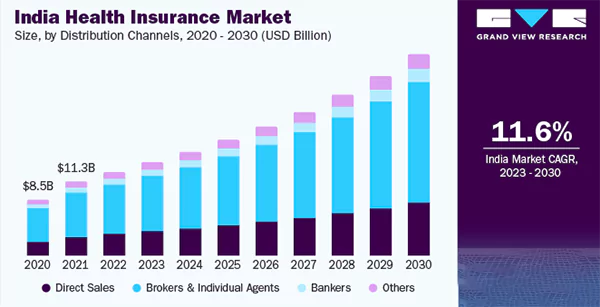Introduction
In the progressive landscape of corporate India, the foundation of employee health insurance is undergoing a profound transformation. Concerns are being raised about its adequacy amidst the complex nuances of growing medical care demands.
The traditional model of worker physical and mental well-being has come under scrutiny, its limitations evident in meeting the complex fitness needs of the modern workforce.
It opens up the requirement to employ various strategies to expand the compass and comprehensiveness of corporate health insurance. It also needs to be precisely aligned with the diverse and growing needs of company staff.
This article explores the complexities of inadequate employee health insurance in present-day India.
Why Employee Health Insurance Faces Challenges:
The Indian landscape is witnessing a steady increase in medical expenses, hospitalizations, diagnoses, and specialized treatments.
Group health insurance plans, which were earlier adept at navigating standard medical costs, now bear the financial burden associated with avant-garde medical interventions and sophisticated medical services. Demographic and fitness sector changes require a mandate to examine medical coverage more deeply.
Health insurance initiatives for the aging workforce, coupled with an increase in lifestyle-related diseases and mental medical concerns, should be all-encompassing. At the same time, they should address specific fitness concerns faced by the staff.
THINGS TO CONSIDER
Certain medical benefits such as cashless claims facilities and maternity benefits differ as per the insurance policy.
Historically, traditional workers’ fitness and wellness have been reactive, set primarily to provide a safety net for medical treatment and hospital stays.
The zeitgeist is ushering in a paradigm shift that recognizes the fundamental role of preventive medical care in curbing long-term wellness costs.
The flaw lies in the emphasis on fitness initiatives, periodic medical check-ups, and the complex correlation of lifestyle management within the confines of traditional frameworks.
The traditional narrative of employee health plans reads like a classic, occasionally omitting relevant chapters.
The prevailing focus turns disproportionately toward hospitalization costs while neglecting aspects of non-hospitalization.
Outpatient care, diagnosis, and wellness services are marginalized, and ambiguous as medical plan delivery structures expand toward outpatient and home-centric approaches. This leaves the prevailing fitness framework unchanged.
The family footprint is integrated within the framework of many workers’ medicaid plans which is indispensable in individual wellness.
A shortsighted approach limits coverage to the individual staff, ignoring the basic fitness needs of their dependents, excluding spouses, children, and parents from health insurance coverage creating inadequacy.

Strategies for Expanding Corporate Health Insurance Coverage:
This narrative comes with a call for revolutionary change, urging corporations to integrate comprehensive fitness and wellness initiatives into employee benefits.
The urgency to address several hurdles could be crossed with a blend of preventive medical care, fitness programs, mental health coverage, and lifestyle management.
Zeitgeist highlights a holistic ethos of worker wellness, which is key to uncovering medical disorders at their root, and managing to reduce long-term fitness costs.
Customization emerges as the watchword in the contemporary mosaic of diverse workforces. Corporate medical care plans must progress into flexible entities, tailored to their demographics, wellness profiles, and preferences.
This pre-defined approach should include categorized coverage for different employees and accommodation of individual fitness aspects. It also requires flexibility to navigate emerging fitness trends.
Inclusion strikes at the heart of strategies with every staff’s fitness at a different stage. A model has been proposed where medical coverage is adaptable with a cost-effective non-hospitalization model.
Outpatient care, diagnostics, and preventive medical care plans become internal components of the coverage spectrum.
This evolution positions corporations as leaders of fitness metrics that align with the disorganization of contemporary medical wellness delivery.
The graph below shows the health insurance market size in India which has been consistently expanding since 2020. This indicates that corporations are becoming aware of the necessity of corporate health insurance for employees.

A transformation is underway, moving towards family-centric medical coverage. Corporate health plans must extricate themselves from their comfort zone by recognizing the pivotal role of the family component in an individual’s well-being.
The call resonates for dependents – spouses, children, and parents leading to universal well-being. It is in sync with the shape of the family structure in the contemporary Indian diaspora.
The technology epitomizes efficiency and accessibility in corporate medicaid enrichment. Digital platforms have emerged as masters to promote admissions, claims adjudication, and communication.
Innovation extends to telehealth services with the help of virtual consultation and remote monitoring, creating a cost-effective model, particularly for outpatient wellness and post-consultation engagement.
Investing in education encourages workers to understand the complexities of their medical coverage model, preventive medical facilities, and the use of the abundance of available fitness resources.
This knowledge improves awareness in the workforce and promotes proactive healthcare engagement.
The concluding chapter prompts corporations to engage themselves in a conversation with government initiatives. It helps various fitness-related organizations to embrace the symbiosis of fitness schemes and tax incentives.
Alignment with existing medical frameworks and policies emerges as a backbone moving towards sustainability and inclusion in corporate health insurance.
Conclusion
The fitness sector emerges in an unsettled area, emphasizing transformative co-working with corporate medical coverage in India.
The armor of traditional models echoes the failure to keep stride with the changing tempo of the fitness model. It is driven by rising costs and the urgent needs of a modern workforce.
By adopting comprehensive and proactive measures, corporations not only align with gaps in health insurance coverage but also steer towards the overall well-being and productivity of their employees.
The future of corporate health insurance is aligned with progressive healthcare facilities, depicting a model of strong and comprehensive solutions that strengthen the fitness and wellness of the workforce.